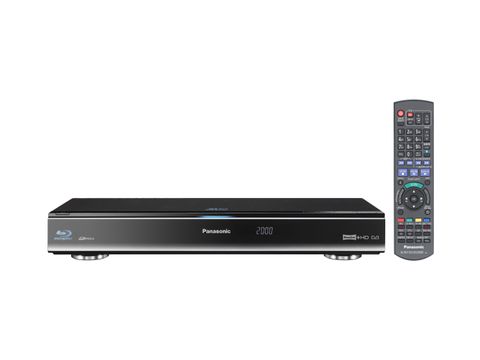TechRadar Verdict
A better option that the far cheaper DMR-BWT700, but still overly complicated compared to dedicated PVRs
Pros
- +
Sparkling images from all sources
- +
All-in-one appeal
- +
Archiving compression options
Cons
- -
Freeview HD EPG
- -
HDD smaller than Sky and Virgin
- -
Fragmented user interface
- -
Remote control
Why you can trust TechRadar
What does the Panasonic DMR-BWT800 Blu-ray recorder / Freeview+ HDD box do?
What doesn't it do, more like.
At its core is an optical drive that can not only play, but also record to Blu-ray, as well as dealing with both 2D and 3D discs.
Record what, you say? The answer comes in the form of two built-in Freeview HD tuners that, together with a 500GB hard disk, make this a Freeview+HD PVR that's as well specified as any on the market.
Naturally it also indulges in perhaps the most useful Freeview+HD feature of all – the pausing and rewinding of live digital TV.
But before you ask, no, it can't record in 3D from the Sky 3D channel.
There are extras, too, in the form of Skype video calling, an SD Card slot (which plays AVCHD video and JPEG photos only), two USB slots (supporting AVI, MKV (DivXHD) and MPEG video files), DLNA streaming (for AVCHD video files) and a novel link to other gear in Panasonic's Diga range of recorders that allows the contents of their HDDs to be shared over a home network.
The same can be done from any PC or laptop packing Windows 7, while online excitement – supplied through Ethernet LAN unless you buy a USB dongle for £80 – culminates in access to Viera Cast, Panasonic's online hub of entertainment.
It's a weak finale, since Viera Cast is last year's tech. The 2011 version of Viera Connect, which features only on Panasonic's flat screen Viera TVs, includes access to the BBC iPlayer. It leaves us feeling a little jealous and a tad cheated – perhaps this isn't quite the all-in-one we'd yearned for.
Elsewhere, the DMR-BWT800 – which is also available as a smaller 320GB hard disk version, the DMR-BWT700 – is thoroughly comprehensive.
Able to archive almost anything shown on Freeview HD to a dual-layer Blu-ray disc, the DMR-BWT800 also deals in AVCHD files, so any HD footage you happen to have filmed on an HD camcorder can also be archived to either the HDD, or to a Blu-ray disc (BD-RE or BD-R types).
That HDD can store around 500 hours of standard definition programmes or 125-ish hours of hi-def, though ultimately you'll probably want a mix of both. Happily, the DMR-BWT800 also deals in surround sound, being capable of storing audio broadcasts in Dolby Digital, Dolby Digital Plus and (the default for most digital programmes on Freeview HD), the compressed HE-AAC format.
To cap it all, this isn't just a 3D Blu-ray disc player, boasting a 2D-to-3D converter that works not only on 2D Blu-ray discs, but on Freeview broadcasts, too. Crucially, it doesn't try to convert live TV – Freeview programmes must first be stored on the HDD – but it's an interesting idea that will tempt those with a 3D TV.
Incidentally, Panasonic's latest crop of Viera TVs can convert anything – including Freeview – on the fly.
Exclusive to the DMR-BWT800 (when compared to the cheaper DMR-BWT700) is a second HDMI output for routing audio to a non-3D Ready AV receiver, as well as Digital Tube Sound (a warm sounding six-sided mode modelled on vacuum tube amplifiers) and Pure Sound, which reduces the interference of the machine's rotating fan and HDD.
Overall, this is the deck to opt for if you plan to make it the beating heart of a 3D home cinema.
Current page: Panasonic DMR-BWT800: Overview and features
Next Page Panasonic DMR-BWT800: Picture qualityJamie is a freelance tech, travel and space journalist based in the UK. He’s been writing regularly for Techradar since it was launched in 2008 and also writes regularly for Forbes, The Telegraph, the South China Morning Post, Sky & Telescope and the Sky At Night magazine as well as other Future titles T3, Digital Camera World, All About Space and Space.com. He also edits two of his own websites, TravGear.com and WhenIsTheNextEclipse.com that reflect his obsession with travel gear and solar eclipse travel. He is the author of A Stargazing Program For Beginners (Springer, 2015),

Surprisingly cheap Pro monitor provides unique features that even Apple Studio display doesn't — AOC's new monitors offer KVM capability, a whopping 11 ports and Hollywood-grade Calman software compatibility

Microsoft should accept that it's time to give up on Windows 11 and throw everything at Windows 12

MSI Titan 18 HX review: a gaming colossus

